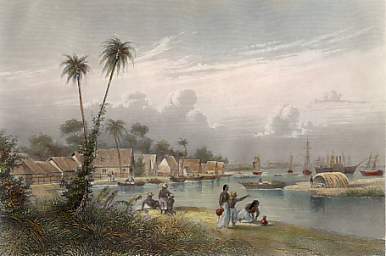 Print of San Juan, Nicaragua, circa 1850
Print of San Juan, Nicaragua, circa 1850
In a period going back to around 1850, five or six generations of Americans have been involved with Nicaragua, a volcanic, earthquake-prone land of forests, lakes and intense blue skies, poor but often beautiful, which is the archetype of the Central American "banana republic," originally so described because it was usually dependent on its fruit-exporting or similar trade. "The possibility of economic riches in Nicaragua attracted international business development," reads the 1850—1868 section of a study archived on the Library of Congress’ website. Among the US citizens who have seriously meddled in Nicaragua’s internal affairs are:
- adventurer William Walker, who made two expeditions to the country in the 1850s and had to be ousted by the US army;
- corporate attorney, US attorney-general and later senator Philander C. Knox, who as secretary of state to President William Howard Taft from 1909 to 1913, in the age of dollar diplomacy, ordered the US Marines in there;
- and, closer to our own times, former National Security Council official Lt. Col. Oliver North (USMC, retired), best known today as a radio commentator.
It is now also nearly 20 years since Ben Linder, a young mechanical engineer from Portland, Oregon, was killed in Nicaragua. He had gone there some 3 years before, fresh out of college, to help in small-scale engineering projects which it was hoped would better the lot of the rural people — most of them still, to this day, extraordinarily impoverished, and disproportionately likely to succumb to disease:
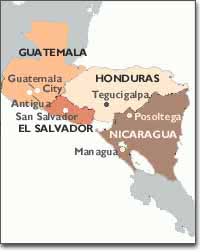 "Nicaragua," according to the country profile on the website of the British government’s Foreign Office, " is …the poorest country in Latin America, with half of her 5.4 million people below the World Bank poverty line. […] Health services are not readily accessible to a majority of the population. In the more isolated regions of Nicaragua, there are almost no physicians. Government clinics are often empty shells lacking adequate personnel, equipment and medicines. Infectious and parasitic diseases are the leading causes of death. Gastroenteritis and tuberculosis are serious problems. Diseases such as influenza, malaria, typhoid and pneumonia, have returned because of a lack of preventive measures."
"Nicaragua," according to the country profile on the website of the British government’s Foreign Office, " is …the poorest country in Latin America, with half of her 5.4 million people below the World Bank poverty line. […] Health services are not readily accessible to a majority of the population. In the more isolated regions of Nicaragua, there are almost no physicians. Government clinics are often empty shells lacking adequate personnel, equipment and medicines. Infectious and parasitic diseases are the leading causes of death. Gastroenteritis and tuberculosis are serious problems. Diseases such as influenza, malaria, typhoid and pneumonia, have returned because of a lack of preventive measures."
The 1980s, when Ben Linder and many other like-minded young idealists were genuinely moved by the opportunity to help less fortunate others in Nicaragua, were the years when the government there was the Sandinista National Liberation Front, led by Daniel Ortega. That government was bitterly opposed by die-hard supporters of the Somoza dynasty, which had ruled and pillaged the country for over 40 years from the mid-1930s onwards. It was also opposed by the US government of Ronald Reagan (1981—1989), which saw the Sandinistas as a dangerously close spearhead of America’s large enemy of the day, international communism.
 A 1986 Time Magazine cover featured an unsmiling Ortega in shades and Comandante uniform, stars and all, against a deep red background with the headline "The Man Who Makes Reagan See Red." "48 Hours from Brownsville" could have been the title of a satirical theme-song for the Reagan era’s national security functionaries, who painted poor Sandinista-ruled Nicaragua as a threat to the United States because it was "only 2 days’ march" from that Texas frontier metropolis.
A 1986 Time Magazine cover featured an unsmiling Ortega in shades and Comandante uniform, stars and all, against a deep red background with the headline "The Man Who Makes Reagan See Red." "48 Hours from Brownsville" could have been the title of a satirical theme-song for the Reagan era’s national security functionaries, who painted poor Sandinista-ruled Nicaragua as a threat to the United States because it was "only 2 days’ march" from that Texas frontier metropolis.
Out of that fixation came first propaganda, and then active US support for the vindictive army of counter-revolutionaries known by their Spanish name, the Contras, who were coached and directed by the CIA. In its later stages the Contra war was funded, in defiance of the Boland Amendment passed by the US Congress, by the proceeds of under-the-table US government sales of weaponry to Iran, and by arms-for-drugs deals supervised by those same former state officials and their associates. Some of their most ardent supporters, in the run-up to the 2006 elections, have been lining up to warn for over a year of the dire consequences which would follow if the Nicaraguan people re-elected Ortega. They usually forgot to mention that Ortega’s running-mate this time around was Jaime Morales, a former Contra, whose ample residence Ortega had commandeered for himself during the eighties — and held on to ever since, having recently agreed a compensation deal with its former owner.
It was a Contra grenade which, on April 27, 1987, first injured Ben Linder and his two Nicaraguan colleagues, before he was executed by a shot to the head. As with the death of Rachel Corrie, another young American idealist in another place and time, there was an outcry in the international media, and a fierce reaction in America. As British journalist Matthew Campbell points out, few issues ever polarized opinion in the US as much as the Sandinistas. Already in the days of the Reagan imperium, you were "either with us or against us." Elliot Abrahams, then assistant secretary of state for Western Hemisphere Affairs, was quoted as saying that Linder simply should have known better than to be in a combat zone. A more forthright Bush the elder, vice-president at the time, said merely that Ben Linder "was on the wrong side."
Some readers may recall that Abrams, heavily implicated in operations in support of the Contras, lied defiantly about this in congressional testimony, finally pleading guilty to perjury in 1991 in order to avoid a felony charge. None of this stopped George Bush the younger in June 2001 appointing the u2018combative’ Abrams to his national security council as director of its Office for Democracy, Human Rights And International Operations, and later, in December 2002, as senior director for Near East and North African Affairs — just in time for the invasion of Iraq. In February 2005 he was appointed deputy National Security Advisor.
Other noted "veterans" of intervention in Nicaragua and the lethal Iran-Contra affair also made it into the Bush/Cheney administration: John D. Negroponte, Otto J. Reich, John M. Poindexter, and later the ill-starred Porter Goss, who recently (May 2006) resigned his job as head of the CIA, apparently for making a hash of it. Little known and never mentioned in the litany of seeming perplexity with which the mainstream media greeted his appointment to that office in 2004, Goss was allegedly involved in Nicaragua in the dying days of the Somoza regime in 1979, as part of the agency’s clandestine efforts to forestall the inevitable by carrying out sundry assassinations, or attempted assassinations, of Sandinista top brass, including Ortega and his brother. The apparently overzealous Goss had been u2018a rising star’ in the company during the tenure of his good friend George Bush the elder in the mid-1970s, even though he had officially left the agency in 1972.
 To his credit, CBS journalist Dan Rather took a rather different view of Ben Linder’s death:
To his credit, CBS journalist Dan Rather took a rather different view of Ben Linder’s death:
Benjamin Linder was no revolutionary firebrand, spewing rhetoric and itching to carry a rifle through the jungles of Central America. He was a slight, soft-spoken, thoughtful young man. When, at 23, he left the comfort and security of the United States for Nicaragua, he wasn’t exactly sure what he would find… But he wanted to see Nicaragua first-hand, and so he headed off, armed with a new degree in engineering, and the energy and ideals of youth… This wasn’t just another death in a war that has claimed thousands of Nicaraguans. This was an American who was killed with weapons paid for with American tax dollars. The bitter irony of Benjamin Linder’s death is that he went to Nicaragua to build-up what his own country’s dollars paid to destroy — and ended up a victim of the destruction… The loss of Benjamin Linder is more than fodder in an angry political debate. It is the loss of something that seems rare these days: a man with the courage to put his back behind his beliefs. It would have been very easy for this bright, young man to follow the path to a good job and a comfortable salary. Instead, he chose to follow the lead of his conscience.
In the Contras’ war of terror, Ben Linder was one of over an estimated 30,000 people killed. During the 1990s, when the Senate Intelligence Committee was looking at the deaths of other US citizens in Central America, attempts in the US House of Representatives to have his death investigated in greater depth came to nothing.
In the International Court of Justice, however, Nicaragua had in 1986 successfully sued the government of the United States, being awarded $17 billion on six counts of damages arising out of the Reagan administration’s support for the Contras and direct US military intervention, including the mining of Nicaraguan ports. The US government reacted to this, after the verdict, by withdrawing its earlier declaration accepting the Court’s compulsory jurisdiction. The US ambassador to the United Nations, Jeanne Kirkpatrick, dismissed the Court as a “semi-legal, semi-juridical, semi-political body which nations sometimes accept and sometimes don’t.” So there!
 But it was in any case a no-win situation for the Sandinista government. Already at the time of Ben Linder’s death, its earlier efforts to reverse some of the depredations of the Somoza family by (forcibly and too hastily) redistributing the family’s ill-gotten land holdings, and to raise the abysmal levels of basic health care and education, had given way to severe curtailment of civil liberties, the imprisonment of opponents, the channeling of over 80% of government revenues to fighting the war against the Contras, and the reported presence of a raft of Cuban and East German advisers sent as proxies for the Muscovite "evil empire."
But it was in any case a no-win situation for the Sandinista government. Already at the time of Ben Linder’s death, its earlier efforts to reverse some of the depredations of the Somoza family by (forcibly and too hastily) redistributing the family’s ill-gotten land holdings, and to raise the abysmal levels of basic health care and education, had given way to severe curtailment of civil liberties, the imprisonment of opponents, the channeling of over 80% of government revenues to fighting the war against the Contras, and the reported presence of a raft of Cuban and East German advisers sent as proxies for the Muscovite "evil empire."
The culmination came in the elections of 1990, in which a Unified Opposition Front came to power, strongly backed by the United States government and its favored instrument for such occasions, the National Endowment for Democracy. The front was led by Violetta Chamorro, the widow of the liberal newspaper editor Pedro Chamorro, assassinated in the time of the Somozas. The transition however, was messy. A legacy of outstanding property claims, and successful efforts by many Sandinistas to hold on to some of their own gains of both wealth and power, meant that the new government was not as promptly compliant as the imperial masters in Washington wished and expected. Violetta Chamorro later had to be strong-armed into withdrawing Nicaragua’s World Court claim against the US, on pain of losing ongoing US financial backing.
Her successor as president, Arnaldo Aleman, was so blatantly crooked that he was eventually convicted of embezzlement and corruption, and sentenced to 20 years in jail. Always keen to encourage clean behavior in others, Washington punished many of his equally corrupt associates by revoking their US visas. No doubt the bureaucratic thinking went something like this: if you won’t at least be seen to behave, then we won’t let you or your wives or mistresses visit LA to see your relatives, nor go shopping on Fifth Avenue, so there!
The old enemy Ortega remained. He was still the leader of the Sandinista National Liberation Front. He had stood unsuccessfully in every subsequent election since the 1990 debacle. Consistently, a majority of Nicaraguans said they did not want him back. By around 2002 the realization had no doubt dawned (certainly in the mind of his close associates) that both an image makeover and some deft manipulation of the goalposts were required. It was time to bring Ortega’s skills in political tradecraft up to date.
Ortega made a constitutional pact with the corrupt Aleman, involving fundamental changes to the separation and balance of powers between president and parliament. He was thus able to reinforce the position he had achieved earlier by stashing the parliament and the courts with party men who could be relied on to get him out of trouble in a tight spot, as they did when he was plausibly accused of having sexually abused his step-daughter. The bar was also lowered on the percentage of votes required to win in the first round of any future presidential election (from 40% to 35%). A legitimate potential rival contender for the Sandinista leadership, the popular former mayor of Managua, the late Herty Lewites, was unceremoniously ejected from the party. More controversially, Ortega aligned himself with the Catholic church and supported the outlawing of even therapeutic abortion (in the case where the pregnancy endangers the mother’s life), which had been legal since 1893.
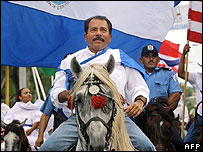 With his image made over by his wife, who dressed him in democratic blue jeans in place of the long-discarded guerilla’s uniform, and a campaign featuring promises of a fairer future enveloped in the new, less violent colors — pink and white (no more red) — Ortega was reported as having achieved a percentage of around 38% of the vote on November 5th. Thus, under the new rules he had himself had a part in devising, he was elected President without having to go to a second round, which he would almost certainly have lost.
With his image made over by his wife, who dressed him in democratic blue jeans in place of the long-discarded guerilla’s uniform, and a campaign featuring promises of a fairer future enveloped in the new, less violent colors — pink and white (no more red) — Ortega was reported as having achieved a percentage of around 38% of the vote on November 5th. Thus, under the new rules he had himself had a part in devising, he was elected President without having to go to a second round, which he would almost certainly have lost.
International reaction to the election result has been rather muted. Some on the traditional left are hoping that an Ortega government, may yet be able genuinely to "do something" for the people, assisted perhaps by Hugo Chavez of Venezuela, who, in place of Moscow’s always rather threadbare mantle of fairy godmother to the revolution, brings more practical promises to supply diesel fuel to keep the lights on in Managua. I fear such hopes will be in vain, though it would not take much to lift Nicaragua just a little bit out of the depths of its poverty. Experience tends to show that leaders of governments, whatever their campaign colors, and whether they wear flight suits to land on aircraft carriers, jeans on a donkey, or suits in the UN General Assembly, will never do anything much for the people other than make extravagant promises which they can’t keep.
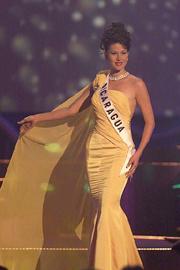 Those on the traditional right point to new trade and investment opportunities and the supposedly already visible benefits of Nicaragua’s accession to the Central American Free Trade Area (CAFTA) in 2005, in the form of increased exports of primary agricultural products, particularly to the US. Real estate near the idyllic Pacific coast surfing beaches seems to offer good prospects — for foreign, mainly US, investors. Others say Nicaragua is, regrettably, emulating Fidel Castro’s Cuba, which has become a beach and sex-tourism hotspot mainly for Europeans (the current US government still forbids most of its citizens from going to Cuba, or fines them heavily for doing so. For government, it seems, no simple human or artistic purpose can ever be innocent). Certainly, from a masculine point of view, Nicaraguan womanhood has a reputation for charm and beauty as seductive as that of Cuba, but that doesn’t mean government should start issuing licenses for their exploitation.
Those on the traditional right point to new trade and investment opportunities and the supposedly already visible benefits of Nicaragua’s accession to the Central American Free Trade Area (CAFTA) in 2005, in the form of increased exports of primary agricultural products, particularly to the US. Real estate near the idyllic Pacific coast surfing beaches seems to offer good prospects — for foreign, mainly US, investors. Others say Nicaragua is, regrettably, emulating Fidel Castro’s Cuba, which has become a beach and sex-tourism hotspot mainly for Europeans (the current US government still forbids most of its citizens from going to Cuba, or fines them heavily for doing so. For government, it seems, no simple human or artistic purpose can ever be innocent). Certainly, from a masculine point of view, Nicaraguan womanhood has a reputation for charm and beauty as seductive as that of Cuba, but that doesn’t mean government should start issuing licenses for their exploitation.
Perhaps there is a cynical and dispiriting acceptance that in Nicaragua as elsewhere, politics and government continues to be about power and pelf, and how to keep hold of them at the expense of possible rivals. And this is just one factor preventing anything truly positive and helpful from being achieved by governments.
For all these reasons, Ortega is unlikely to pick up where he left off in 1990 or earlier. Indeed, given the scale and intensity of the corruption and manipulation in recent years, it is possible that watchers and players in Nicaraguan politics have adapted to the time-honored and even more cynical threat of public humiliation, honed to a fine art in Washington by political managers like Karl Rove (Republican) and Rahm Emanuel (Democrat). This is a tough game in which the depredations of those in power, and the ambitions of those out of power, are held in check by dirt — real or concocted — which the other side, or the "new cardinals" themselves, keep ready to be dished to a complicit, scandal-hungry media at a moment’s notice.
No doubt also many other former Sandinistas, like Ortega, have toned down their revolutionary zeal, as they have learned that the political trough doesn’t have to be all yours in order to become fat on it. That indeed was the mistake the Somozas made. They lost it all because, in their increasingly desperate attempts to stay in power, they were fatally prone to using blunt instruments such as robbery, assassination and bombing of their own people. The latter technique rebounded on them spectacularly when the last of the dynasty to hold power, Anastasio Somoza Debayle, was shot to pieces and his car blown up in Paraguay in September 1980.
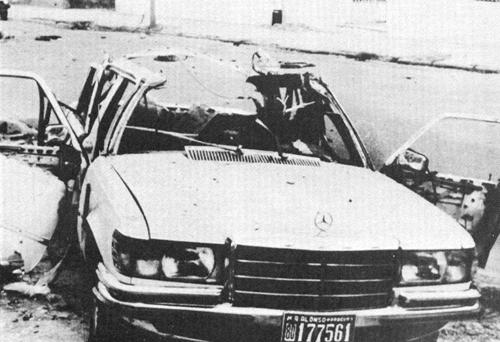 Wreckage of Anastasio Somoza’s car in Paraguay, Sept. 17, 1980
Wreckage of Anastasio Somoza’s car in Paraguay, Sept. 17, 1980
A still only partly declassified US intelligence report describes how "Somoza’s car was hit by a projectile from a rocket-launcher, which blew off the roof and killed any occupant not already dead as a result of the automatic weapons fire which preceded the rocket attack." Greedy tyrants, be warned!
What about the future for Nicaragua? In 2007 and beyond, the context we will have is globalization, biotechnology and wars, both present and future, verbal and real, over natural resources and the environment. Nicaragua has coffee, fruits, forests, and seeds, all attractive to the masters of agribusiness for potential acquisition, genetic modification, and subsequent exploitation as commodifiable intellectual property. It also has coastlines both Atlantic and Pacific, which have long encouraged thoughts of a super-canal to rival Panama’s and facilitate the passage of giant container ships carrying cargoes of manufactures from China. Goodbye lakes and forests, hello oil spills and chemicals! And so, for those coming conflicts, I have a sinking feeling Nicaragua’s role as a rich exploitable resource in the global plantation has already been assigned, with hardly a thought for the still impoverished people who will be required to work it.
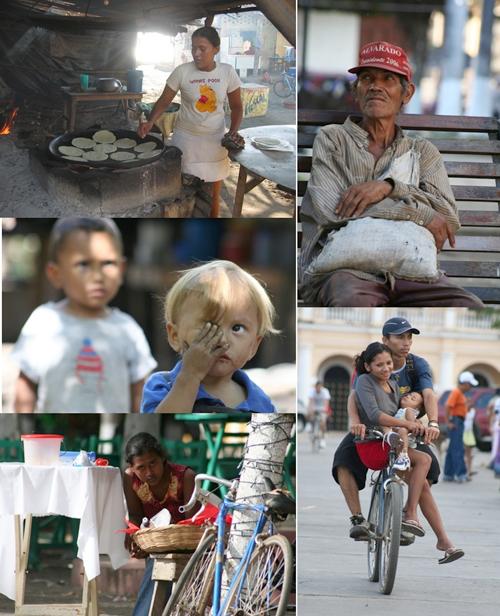 People of Nicaragua (Photos courtesy of Willem Moors)
People of Nicaragua (Photos courtesy of Willem Moors)
The problem, as always, is that revenues from agricultural exports and other projects will be allocated in the first instance to payments of interest on international indebtedness. Nicaragua, like so many poor nations, is locked into the cycle of debt repayment to the international banks. One of the primary roles of US diplomatic representatives in this context becomes that of monitoring the political and economic climate, looking out for and possibly "neutralizing" any looming threats to "stability" — the stability of Wall Street and London banking profits in particular.
In plain language this means, as it has always meant, that they must ensure countries like Nicaragua do not fall behind with their debt payments, and in this role they are merely the blander and more acceptable civilian successors of the former military presence. In Nicaragua, that role would be eminently consistent with the long history of US oversight and intervention in favor of Wall Street. In 1935, at the age of 54 and after he had retired from the US military, Major-General Smedley Butler described his period of service thus:
"I spent thirty-three years and four months in active service in the country’s most agile military force, the Marines. I served in all ranks from second Lieutenant to Major General. And during that period I spent most of my time being a high-class muscle man for Big Business, for Wall Street and the bankers….I helped purify Nicaragua for the international banking house of Brown Brothers and Co. in 1909—1912."
And so it goes. Even Ortega, according to an Associated Press report a shadow of his former revolutionary self, seems to be bending over backwards to provide reassurance: "His speeches have focused on reassuring skeptics that he plans no radical changes and will embrace free trade, job creation and close US ties."
 Ben Linder and Nicaraguan kids
Ben Linder and Nicaraguan kids
Ben Linder and his memory rest in Nicaragua. His gravestone reads: "Benjamin Ernest Linder, Internationalist. Born July 7, 1959 California, USA. Fell April 28, 1987, San Jose del Bocay Jinotega, Nicaragua. The light he lit will shine forever."
And so it does, in a humble, slightly ironic, but fitting monument to a goodness of heart utterly different to what is represented by the company of rogues, plotters and murderers who infest the services of government.
References and Further Links
Articles
Richard Feinberg, Nicaragua, What’s At Stake. Latin Business Chronicle, July 31, 2006 (the author is Professor at the Graduate School of International Relations and Pacific Studies, University of California, San Diego. Previously, he served as President Clinton’s Latin American expert on the National Security Council).
Richard Feinberg, Nicaragua Elections: Too Close to Call. Latin Business Chronicle, October 16, 2006
Susan Frisbie, The Road to the November Elections. Nicaraguan Developments, Volume 22, No. 3, Fall 2006
(the "neo-missionary" view from the Wisconsin Coordinating Council on Nicaragua (WCCN), a committee to promote social justice).
Lisa Haugaard, Foreign Policy in Focus: Nicaragua. Foreign Policy in Focus, Vol. 2 No. 32, March 1997
Stephen Johnson. Help Nicaraguan Democrats Block "Creeping Coup." The Heritage Foundation, November 7, 2005 (somewhat reactionary but highly knowledgeable commentary, written a year before the Nicaraguan elections).
Stephen Johnson. Ortega’s Comeback: Charisma with an Iron Grip? The Heritage Foundation, November 8, 2006 (Johnson’s more sober post-election comments).
Steven Kinzer, Our Man in Honduras. The New York Review of Books, Vol. 48, Number 14 September 20, 2001 (analysis of the career of John D. Negroponte up to 9/11)
Saul Landau and Farrah Hassen, A Transfer of Power, Sort Of. CounterPunch, July 10—12, 2004
Sergio Ramirez, After Lewites. OpenDemocracy.net, July 4, 2006 (Nicaraguan writer, former vice-president in the Sandinista government)
Sergio Ramirez, Don’t Forget Nicaragua. OpenDemocracy.net, October 11, 2006
Murray Rothbard, Reagan, Warmonger. Libertarian Forum, Vol. XVII, Nos. 7—8, July—August, 1983
Tony Solo, Unicorn Hunting in Nicaragua. ZNet, July 24, 2005 (uncompromising view from the hard left, opposing neoliberal intervention and politics).
Alvaro Vargas Llosa, Nicaragua Upside Down, The Independent Institute, November 8, 2006
Books and Book Excerpts
William Blum, 2003 [1996]. Killing Hope. Common Courage Press.
Noam Chomsky. 1992. "Teaching Nicaragua a Lesson," in What Uncle Sam Really Wants. Odonian Press.
Joan Kruckewitt, 2001. The Death of Ben Linder, Seven Stories Press.
David Model, 2005. "President Ronald Reagan and Nicaragua" in Lying for Empire. Common Courage Press.
Murray Rothbard, 1995 [1984]. Wall Street, Banks and American Foreign Policy, Ludwig von Mises Institute.
 Movies
Movies
Carla’s Song, 1996. Directed by Ken Loach, starring Robert Carlyle and Oyanka Cabezas.
Walker, 1987. Directed Alex Cox, starring Ed Harris.
Website
The National Security Archive’s Nicaragua collection: Nicaragua: The Making of U.S. Policy, 1978—1990



